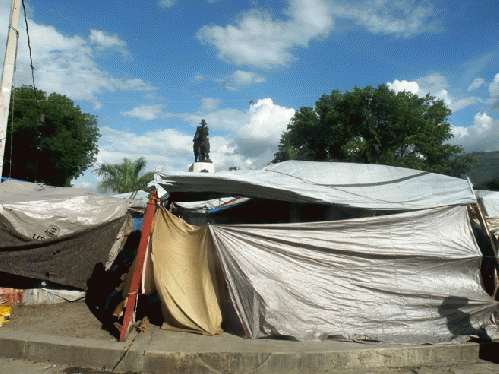Georgianne Nienaber and I are on assignment in Haiti this week. We flew into Port-au-Prince early Monday morning, May 10, 2010, quickly emerging into the hot tropical sun as we walked out of the small terminal our plane had been assigned to, past a band of "greeter" musicians playing a loud and rhythmic Creole-style tune, and onto the waiting shuttle bus that transported us to the customs hangar. Once through customs, we plunged intoa sea of impatient arrivees awaiting their rides like we would soon be, Haitian police officers, French military police, Haitian airport workers and heavily armed and armored SWAT Team personnel, not to mention an array of neatly badged and attired cab drivers, all sporting white short-sleeve shirts and black slacks, both men and women.
It wasn't long before our "Fixer", Andre, showed up to lead us to the Dodge Raider he had just parked nearby, commencing our still-being-formulated Haitian road adventures for the day as soon as he turned on the ignition. We were quickly onto famous Highway One and heading east toward two refugee camps in the nearby mountains (more on that later) where we investigated all morning into the early afternoon before doubling back, driving through Cità � Soleil and the giant open marketplace route through Port-au-Prince.
After checking into our hotel, unpacking and beginning to plan our next itinerary, a not uncommon late afternoon rainstorm struck, often in heavy deluges, which led us to ask ourselves, "How badly are the myriad tent cties in and around Port-au-Prince being impacted by these heavy downpours?" We had already seen how flimsily strung together, not to mention thin many of the famous "blue tarp tents" were, so our concern and curiosity eventually led us to grab our raingear and drive off to the nearest tent city, Champs de Mars (Field of Mars) an area right next to the White House (the Presidential Palace).
It was already dark and still raining when we parked our car on the sidewalk at a big intersection that fell below the large and imposing statue of Haitian revolutionary leader Henri Christophe. Surrounding the statue and extending back for blocks in haphazard and chaoticmanner was row after row of strung, tied, taped, sown or otherwise joined together tents and shelters.
As soon as Andre began to explain to the suddenly curious citizens of Champs de Mars why we were there, both Georgianne and myself suddenlyfound ourselves each being grabbed by the wrist by competing parents, all of whom wanted us to see the kind of living conditions they and their families were endurng in the rain, or even in the sunlight for that matter. The first few tents I entered rather shocked me, the floors made of dirt now transforming to mud, usually at least several children trying to sleep, if they were lucky, on a hopefully dry mattress, some even on the floor, while their parents moved about trying to deflect water, each small space crowded with cooking utensilsand buckets, some to catch the rainwater, others to hold drinking water, as well as clothing, boxes and various and sundry other personal items.
The only lights permeating this sea of tarps, blankets and plastic were those from high and powerful street floodlights externally, while internally, either dimly glowing bulbs hooked up to car batteries or small candles provided any kind of luminance. And what little light there was revealed, in the larger picture, a country still living close to the edge of the precipice, still walking a tightrope between social collapse and survival some four months after the horrific earthquake of January 12th struck, as you will see in these photos.
The point where we would enter the Champs de Mars tent city during the day:
That same point on the evening of April 10th as it poured down rain:
Some of the tarp "walls" creating this tent city:
An elderly Haitian woman concerned with the leaking tarps all around her:
Inside one tent, a man and a woman try to stay warm and dry:
Buckets are used both to catch the rainwater as best they can and hold what becomes family drinking water. Rain in this instance is leaking right on this family bed.
Closeup of rain drops across the ceiling tarp in a tent:
The floors are made of dirt, so dripping rain will produce this inside a tent, and all you can do is thwow something over it if you can:
This tottler moves around while a bucket catches water an arms length away on his bed.
(Note: You can view every article as one long page if you sign up as an Advocate Member, or higher).





